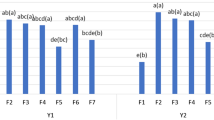Abstract
This study examined the effects of different biofertilizers and manure on the absorption and absorption efficiency of macronutrients by wheat in Alborz Province, Iran. The experimental design was factorial in the form of a randomized complete block design with three replications. The four factors of the experiment were Azospirillum (with 600 g/ha and without), mycorrhiza (with 1 kg/ha and without), Streptomyces (with 0.5 kg/ha and without) and manure (with 30 t/ha and without). To measure N, P and K, plants were harvested one time when grains were at dough stage and another time at plant maturity, oven dried, grinded and analyzed. Azospirillum, mycorrhiza and manure had a significant effect (p ≤ 0.01) on most of the measured traits, but the effect of Streptomyces was not significant. The two-fold and three-fold interactions significantly affected the absorption and absorption efficiency of the three macronutrients. In most cases, four-fold interactions yielded the highest values. Overall, the experimental results indicate that biofertilizers and manure can naturally meet most of the plant’s nutritional requirements, improve the efficiency of nutrient absorption and replace part of chemical fertilizers in sustainable agricultural production systems.
Similar content being viewed by others
References
Allen MF (1991) The ecology of mycorrhiza. Cambridge University Press
Bashan Y, Levanony H (1990) Current status of Azospirillum inoculation technology: Azospirillum as a challenge for agriculture. Can J Microbiol 36:591–608
Bhattarai T, Hess D (1993) Yield response of Nepalese spring wheat (T. aestivum) cultivars to inoculation with Azospirillum spp. of Nepalese origin. Plant Soil 151:67–76
Crossman SM, Hill WA (1987) Inoculation of sweet potato with Azospirillum. Hort Sci 22:420–422
Daei G, Ardakani MR, Rejali F, Teimuri S, Miransari M (2009) Alleviation of salinity stress on wheat yield, yield components, and nutrient uptake using arbuscular mycorrhizal fungi under field conditions. J Plant Physiol 166:617–625
Dobereinea J (1989) Isolation and identification of root associated diazotrophs. Plant Soil 110:207–219
Elmerich C (1986) Azospirillum. In: Broughton WJ, Puhler S (eds) Nitrogen fixation (vol: IV). Clarendon
Elmerich C, Zimmer W, Vieille C (1992) Associative nitrogen-fixing bacteria. In: Stacey et al (eds) Biological nitrogen fixation. Chapman and Hall
Fallik E, Okon Y (1996) Inoculants of Azospirillum brasilense: biomass production, survival and growth promotion of Setaria italica and Zea mays. Soil Biol Biochem 28:123–126
George E, Haussler K, Kothari SK, Li XL, Marschner H (1994) Contribution of mycorrhizal hyphae in ecosystems. CAB International
Jain DK, Patriquin DG (1985) Characterization of substance produced by Azospirillum with causes branching of wheat root hairs. Can J Microbiol 31:206–210
Kapulnik Y, Okon Y, Kigel J, Nur I, Henis Y (1981) Effect of temperature, nitrogen fertilizer and plant age on nitrogen fixation by Setaria italica inoculated with Azospirillum brasilense. Plant Physiol 63:340–343
Kuchaki A, Nakhforushi AR, Zarifketabi H (1997) Organic agriculture. Ferdowsi University Press (in Farsi)
Lambert DH, Weidensaul TC (1991) Element uptake by mycorrhizal soybean from sewage sludge treated soil. Soil Sci Soc Am J 55:393–398
Lin W, Okon Y, Hardy RWF (1983) Enhanced mineral uptake by Zea mays and Sorghum bicolor roots inoculated with Azospirillum brasilense. Appl Environ Microbiol 45:1775–1779
Marschner H, Dell B (1994) Nutrient uptake in mycorrhizal symbiosis. In: Robson AD, Abbot LK, Malajczuk N (eds) Management of mycorrhizas in agriculture, horticulture and forestry. Kluwer
Marty MG, Ladha JK (1987) Differential colonization of Azospirillum lipoferum on roots of two varieties of rice (Oryza sativa). Biol Fertil Soils 4:3–7
Mehlich A (1978) New extractant for soil test evaluation of phosphorus, potassium, magnesium, calcium, sodium, manganese, and zinc. Commun Soil Sci Plant Anal 9(6):477–492
Mertens T, Hess D (1984) Yield increase in spring wheat (T. aestivum) inoculated with Azospirillum lipoferum under greenhouse and field conditions of a temperate region. Plant Soil 82:87–99
Miller RW, Gardiner DT (1998) Soils in our environment. Simon and Schuster
Miller M, Mcgoingle T, Addy H (1994) An economic approach to evaluate the role of mycorrhiza in managed ecosystems. In: Robson AD, Abbot LK, Malajczuk N (eds) Management of mycorrhizas in agriculture, horticulture and forestry. Kluwer
Mostajeran A, Zuie F (1999) Symbiosis-mycorrhiza. Esfehan University Press (in Farsi)
Patriquin DG, Dobereinea J, Jain DK (1983) Sites and processes of association between diazotrophs and grasses. Can J Microbiol 22:900–915
Plenchette C, Furlan V, Fortin A (1983) Response of endomycorrhizal plants grown in calcined montmorillonite clay to different levels of soluble phosphorus. Can J Bot 61:1377–1383
Powell CL, Baggara DJ (1986) VA mycorrhiza. CRC Press
Sarachi M, Quaroni S, Sardi P, Petrolini B (1991) Relationships between Streptomyces sp. S57 and roots and its utilization in the improvement of crop production. New approaches in biological control of soil-born diseases. In the Proceeding Workshop, Copenhagen, Denmark. 30 June–4 July
Sardi P, Sarachi M, Quaroni S, Petrolini B, Borgonovi G, Meril S (1992) Isolation of endophytic Streptomyces strains from surface sterilized roots. Appl Environ Microbiol 58:2691–2693
Siddiqui ZA, Akhtar MS, Futai K (2008). Mycorrhizae: sustainable agriculture and forestry. Springer
Sprent JI, Sprent P (1990). Nitrogen fixing organisms. Chapman and Hall
Stacey G, Burris RH, Evans HJ (1992). Biological nitrogen fixation. Chapman and Hall
Tarafdar JC, Marschner H (1994) Efficiency of VAM hyphae in utilization of organic phosphorus by wheat plants. Soil Sci Plant Nutr 40:593–600
Triplett EW (1996) Diazotrophic endophytes: progress and prospect for nitrogen fixation in monocots. Plant Soil 186:29–38
Violante A, Huang PM, Bollag JM, Gianfreda L (2002) Soil mineral-organic matter-microorganism interactions and ecosystem health. Elsevier, Amsterdam
Author information
Authors and Affiliations
Corresponding author
Rights and permissions
About this article
Cite this article
Ardakani, M.R., Mazaheri, D., Mafakheri, S. et al. Absorption efficiency of N, P, K through triple inoculation of wheat (Triticum aestivum L.) by Azospirillum brasilense, Streptomyces sp., Glomus intraradices and manure application. Physiol Mol Biol Plants 17, 181–192 (2011). https://doi.org/10.1007/s12298-011-0065-7
Published:
Issue Date:
DOI: https://doi.org/10.1007/s12298-011-0065-7




